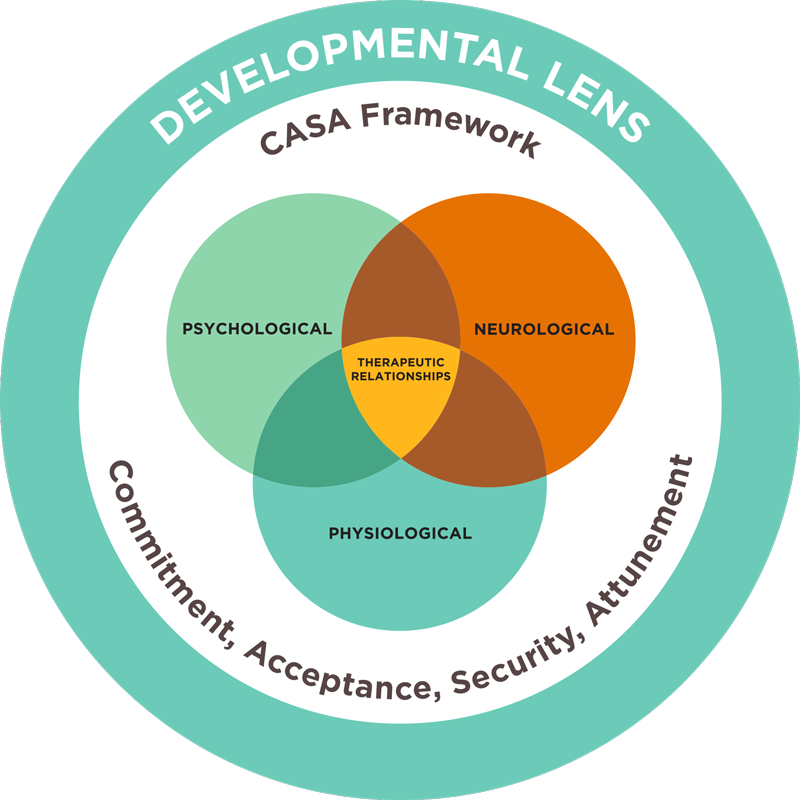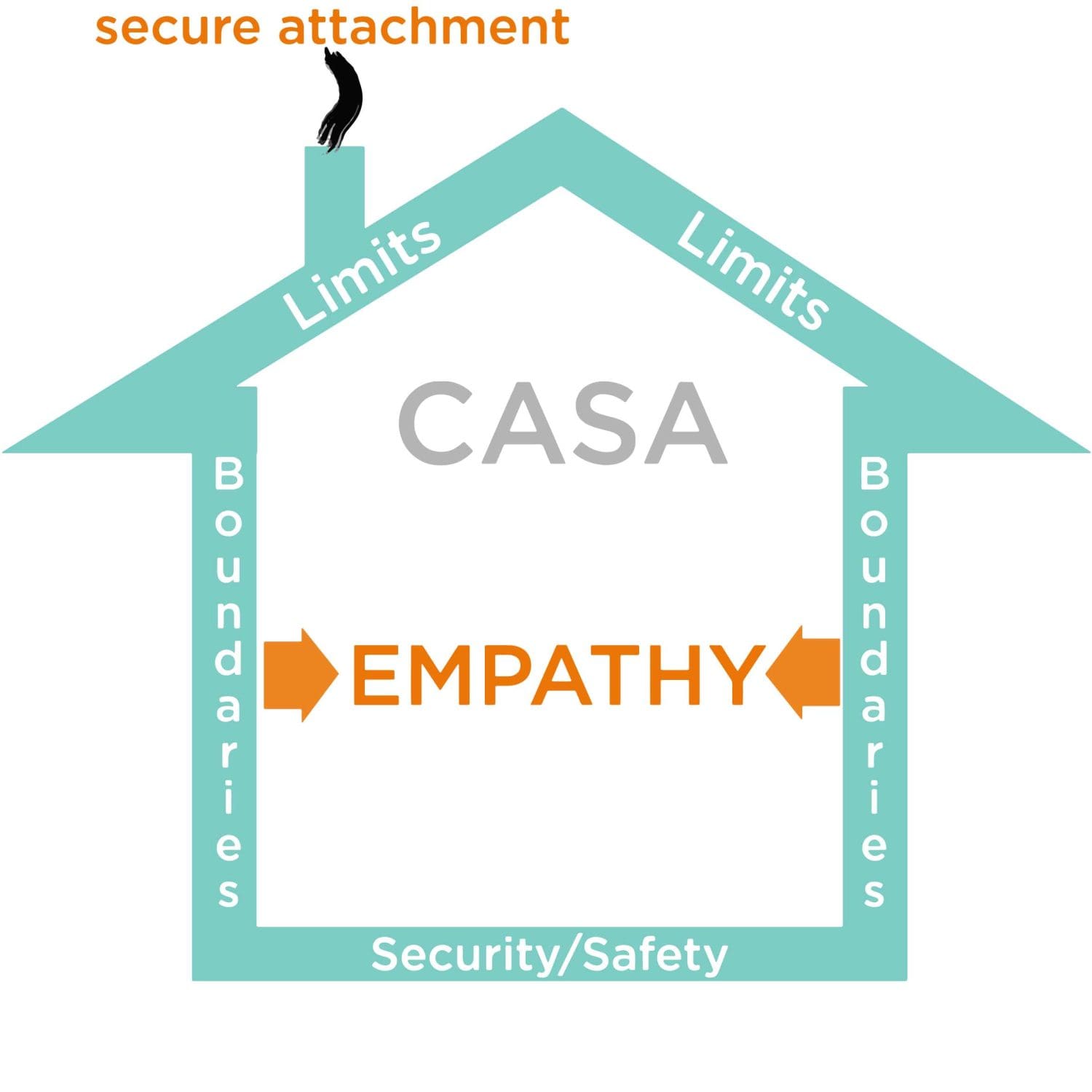CASA Developmental Framework
What Is the CASA Developmental Framework™?
A prescriptive way of creating a therapeutic relationship, the Commitment, Acceptance, Security, Attunement (CASA), framework’s purpose is to developmentally heal and strengthen the functional, mental and physical health of teenagers, young adults, and their families, by creating joy that is experienced through co-regulation.
The CASA Developmental Framework is the neurobiological methodology for creating experiences of secure attachment.
This therapeutic approach is centered on developmental research which indicates that mutually beneficial attachment and secure relationships are necessary for a person's emotional, functional, physical and relational health.

In short, CASA provides teens and young adults who have experienced developmental difficulties and disruption (i.e. developmental trauma), or overwhelming, traumatic stress in early childhood, with secure relationships that provide reliable and responsive care.
This leads to an increase of self-worth, reduction of shame, and the ability to find meaning in suffering which is defined as “joy.”
These secure relationships counter the core shame produced from:
- Abandonment
- Abuse
- Early developmental disruption
- Inconsistent caregiving
- Neglect
That the teenagers may have experienced in their early life.
How the CASA Framework Leads to Joy
When a teenager or young adult with developmental disruption (i.e. trauma) begins to reliably and predictably experience CASA in a committed home, it emotionally, neurologically and physically builds experiences of self-worth and value, which enables a capacity for empathy, gratitude, humility and safe intimacy which are essential to experiencing joy.
This joy is accomplished when reliable caregivers (parents, therapists, etc.) provide their children with the following:
1. Commitment
Parent(s) or other safe relationships that are dedicated to doing what is developmentally best for the teen or young adult. Parents evidence their commitment through sending their child to a residential treatment center when maintaining developmental growth and safety are compromised. Commitment shows that parents are dedicated to the treatment process and the therapeutic work required to restore self-worth and trust in their child.
2. Acceptance
Commitment facilitates the caregiver’s ability to accept the child and embrace them as inherently valuable. Developmentally, healthy individuals require experiences of inherent value which is not contingent on behaviors. Though acceptance can be a difficult process for the parent of a teenager because expectations often block acceptance, accepting and recognizing that the child's developmental difficulties, including early trauma, is driving their behavioral, emotional and relational dysfunction. Accepting that teens and young adults with developmental disruption often fear trusting caregivers and suffer with anxiety and maladaptive behaviors as a means to cope, is a large part of treatment. It is only through acceptance that we can fully move toward the problem and effectively create change.
3. Security
It is only when children predictably and reliably experience acceptance in the form of boundaries, consistent and safe nurturing, and responsiveness from a trusted caregiver, that they internalize the experience of having inherent self-worth and value. The implementation and follow-through of safe parental care is the definition of security. Security is produced when caregivers are committed to doing what is developmentally best, accept the child’s behavioral, developmental and emotional difficulties, and reliably provides for the emotional, physical and relational needs of the child. The ability to accurately provide security for the child requires attunement from the caregiver(s).
4. Attunement
Is empathy in action. When a caregiver is committed, accepting, and able to provide security, they are freed up from anxiety and fear, and able to attune with the child. Attunement requires accurate responsiveness from the caregiver to see beyond the immediacy of the behaviors and embrace and accept the underlying distress creating the dysfunctional behaviors. When attunement from a safe caregiver creates safety and a calming of the nervous system, then co-regulation begins to take root.
Additionally, co-regulation, the reciprocal exchange of emotional, neurological and physical safety is important to the CASA Treatment Model as well.
Co-regulation occurs after repetitive experiences of commitment, acceptance, security and attunement are reliably created. Co-regulation is where therapeutic healing, trauma integration, and restoration of developmental health take place. The CASA experience is necessary for all individuals to develop a healthy ability to self-regulate. These reliable experiences of co-regulation are necessary for effective self-regulation.
Will Your Family Benefit From the CASA Framework?
Though your child may have experienced developmental difficulties, disruption, and/or trauma, with your effort and persistence and our clinicians' professional support, your daughter or son can benefit from CASA and learn how to self-regulate through the commitment, acceptance, security, and attunement necessary in co-regulation.
It is important to note, however, that co-regulation is a constant process and not a steady state.
Teenagers will often move along the cycle of CASA frequently as they experience or re-experience certain aspects of their previous traumatic history. Dysregulation can, and often does, occur, and it is within that moment, that we, as caregivers, must go back to fortify the CASA Framework to confirm that we are committed, accepting and providing safety to our children before we can accurately attune.
Recent Blogs & Tips
CASA In Depth
CASA succinctly describes what the Developmental Framework is and what purpose it serves. The specific language underlying CASA indicates its focus and intention. CASA is a conceptual word which most individuals can comprehend and general develop and idealistic image Is this referring to the Term “House/Home” in translation for CASA?
The term “CASA” is key because its English analog, “Home” is a conceptual work which most individuals can comprehend and generally develop an idealistic image of regardless of their developmental or current experience of “home”. Similar words when asked to think of the characters that “home” should have a safe, loving, nurturing, unconditionally accepting, nonjudgmental, consistent, predictable, reliable, etc. Their universal definitions begin the conceptual construction of the framework based on this ideal image. The meaning of an ideal home is established through safe relationships which are defined through commitment, acceptance, security and attunement from a nurturing, reliable, consistent and predictable caregiver.


CASA House
We utilize the CASA House to illustrate that healthy development means we are all striving – parent, child (yes, even young adult), and therapist – to become the proverbial “Safe CASA.” This represents the qualities and abilities of an individual to be a secure attachment figure.
We ask of the parent(s), “Are you a safe CASA?” This question allows us to transition from the CASA Developmental Framework as theory into a more concrete form where the caregiver is encouraged to access their own sense of “Self” through the explanation of the CASA House.
Safe/Secure Foundation CASA
The caregiver can conceptualize that if they are the “Safe CASA” then they need to possess a secure foundation which allows for the construction of boundaries and limits that produce a stable structure of the house. Being a Safe CASA facilitates trusting relationships through experiences of secure attachment. It also allows for all relationships to experience commitment, acceptance, security and attunement where healthy intimacy, connection and experiences of joy reside.
Reliable and Predictable Boundaries
Healthy individuals have emotional and physically safe boundaries established which are maintained consistently and are not contingent on others. When boundaries are reliably and predictably maintained, then accurate expectations are formed which allow for intimacy and greater vulnerability.
Effective Empathy
Effective empathy exists only if limits and boundaries exist and are reliable, predictable, and consistent. It becomes ineffective when the structural reliability for safe boundaries does not exist. Empathy, which is the most effective experience in shame resolution, is only effective if a person's boundaries are reliable and predictable.
The interplay of empathy, safe boundaries, trust and subsequent predictability unconditional love allows healthy intimacy to flourish and secure attachment to take place. Only this interplay of empathy, safe boundaries, and trust – the creation of the secure CASA – and the subsequent predictable unconditional love allows healthy intimacy to flourish and secure attachment to take place.
Accurate empathy is predicated on safe and consistent boundaries and accurate expectations where acceptance allows for the complete embrace of another’s emotional experience. Developmentally, the goal is for the child, regardless of age, to experience the caregiver as the secure CASA which facilitates integration, maturation, and exploration.










